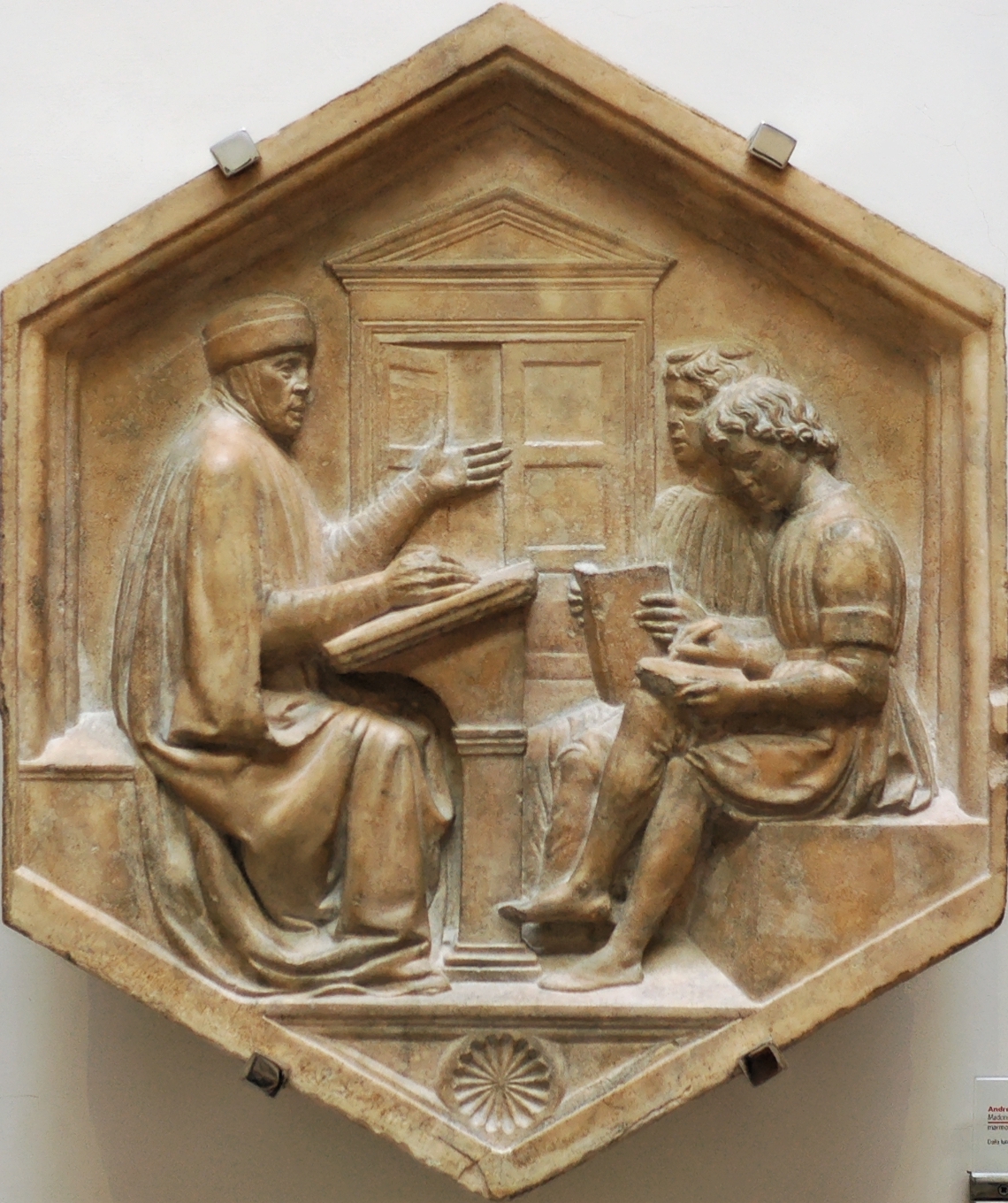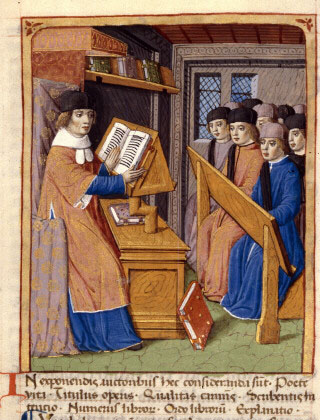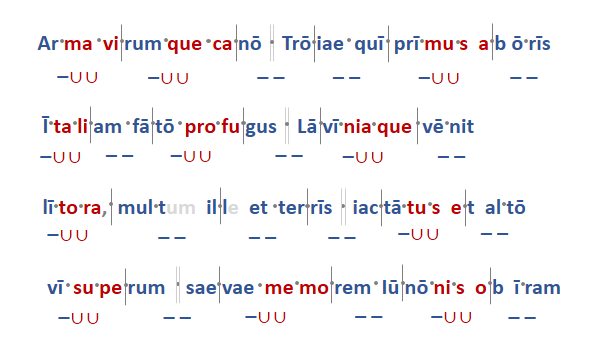|
Ars Grammatica
An ''ars grammatica'' () is a generic or proper title for surveys of Latin grammar. The first ''ars grammatica'' seems to have been composed by Remmius Palaemon (first century AD), but is now lost. The most famous ''ars grammatica'' since late antiquity has been that composed by Donatus and was one of the first experimental texts printed by Gutenberg. Donatus' ''Ars Grammatica'' Two ''artes grammaticae'' circulate under the name Donatus. The first, the ''Ars Minor'', is a brief overview of the eight parts of speech: noun, pronoun, verb, adverb, participle, conjunction, preposition, and interjection (''nomen, pronomen, verbum, adverbium, participium, conjunctio, praepositio, interjectio''). The text is presented entirely in a question-and-answer format (e.g. "How many numbers does a noun have?" "Two: singular and plural."). Donatus' ''Ars Major'' is only a little longer, but on a much more elevated plane. It consists of a list of stylistic faults and graces, including tropes ... [...More Info...] [...Related Items...] OR: [Wikipedia] [Google] [Baidu] |
Latin Grammar
Latin is a heavily inflected language with largely free word order. Nouns are inflected for number and case; pronouns and adjectives (including participles) are inflected for number, case, and gender; and verbs are inflected for person, number, tense, aspect, voice, and mood. The inflections are often changes in the ending of a word, but can be more complicated, especially with verbs. Thus verbs can take any of over 100 different endings to express different meanings, for example "I rule", "I am ruled", "to rule", "to be ruled". Most verbal forms consist of a single word, but some tenses are formed from part of the verb "I am" added to a participle; for example, "I was led" or "he is going to lead". Nouns belong to one of three grammatical genders (masculine, feminine, and neuter). The gender of the noun is shown by the last syllables of the adjectives, numbers and pronouns that refer to it: e.g. "this man", "this woman", "this war". There are also two numbers ... [...More Info...] [...Related Items...] OR: [Wikipedia] [Google] [Baidu] |
Latin
Latin ( or ) is a classical language belonging to the Italic languages, Italic branch of the Indo-European languages. Latin was originally spoken by the Latins (Italic tribe), Latins in Latium (now known as Lazio), the lower Tiber area around Rome, Italy. Through the expansion of the Roman Republic, it became the dominant language in the Italian Peninsula and subsequently throughout the Roman Empire. It has greatly influenced many languages, Latin influence in English, including English, having contributed List of Latin words with English derivatives, many words to the English lexicon, particularly after the Christianity in Anglo-Saxon England, Christianization of the Anglo-Saxons and the Norman Conquest. Latin Root (linguistics), roots appear frequently in the technical vocabulary used by fields such as theology, List of Latin and Greek words commonly used in systematic names, the sciences, List of medical roots, suffixes and prefixes, medicine, and List of Latin legal terms ... [...More Info...] [...Related Items...] OR: [Wikipedia] [Google] [Baidu] |
William Smith (lexicographer)
Sir William Smith (20 May 1813 – 7 October 1893) was an English lexicographer. He became known for his advances in the teaching of Greek and Latin in schools. Early life Smith was born in Municipal Borough of Enfield, Enfield in 1813 to Nonconformist (Protestantism), Nonconformist parents. He attended the Madras House school of John Allen (religious writer), John Allen in Hackney. Originally destined for a theological career, he instead became Articled clerk, articled to a solicitor. Meanwhile, he taught himself classics in his spare time, and when he entered University College London carried off both the Greek and Latin prizes. He was entered at Gray's Inn in 1830, but gave up his legal studies for a post at University College School and began to write on classical subjects. Lexicography Smith next turned his attention to lexicography. His first attempt was ''A Dictionary of Greek and Roman Antiquities'', which appeared in 1842, the greater part being written by him. Then f ... [...More Info...] [...Related Items...] OR: [Wikipedia] [Google] [Baidu] |
Maurus Servius Honoratus
Servius, distinguished as Servius the Grammarian ( or ), was a late fourth-century and early fifth-century grammarian. He earned a contemporary reputation as the most learned man of his generation in Italy; he authored a set of commentaries on the works of Virgil. These works, ("Exposition on Three Works of Virgil"), ("Commentaries on Virgil"), ("Commentaries on the Works of Vergil"), or ("Commentaries on the Poems of Virgil"), constituted the first incunable to be printed at Florence, by Bernardo Cennini, in 1471. In the ''Saturnalia'' of Macrobius, Servius appears as one of the interlocutors; allusions in that work and a letter from Symmachus to Servius indicate that he was not a convert to Christianity. Name The name Servius also appears as Seruius owing to the unity of the Latin letters V and U from antiquity until as late as the 18th century. Many medieval manuscripts of Servius's commentaries give him the praenomen Marius or Maurus and the cognomen Honoratu ... [...More Info...] [...Related Items...] OR: [Wikipedia] [Google] [Baidu] |
Gaius Marius Victorinus
Gaius Marius Victorinus (also known as Victorinus Afer; ) was a Roman grammarian, rhetorician and Neoplatonic philosopher. Victorinus was African by birth and experienced the height of his career during the reign of Constantius II. He is also known for translating two of Aristotle's books from ancient Greek into Latin: the '' Categories'' and ''On Interpretation'' (''De Interpretatione''). Victorinus had a religious conversion, from being a pagan to a Christian, "at an advanced old age" (c. 355), which has been described in Augustine's ''Confessions''. Life Birthplace and early career Victorinus, at some unknown point, left his home of North Africa to live permanently in Rome (hence some modern scholars have dubbed him ''Afer''), probably for a teaching position, and had great success in his career, eventually being promoted to the lowest level of the senatorial order. That promotion probably came at the time when he received an honorific statue in the Forum of Trajan in ... [...More Info...] [...Related Items...] OR: [Wikipedia] [Google] [Baidu] |
Charisius
Flavius Sosipater Charisius ( 4th century AD) was a Latin grammarian. He was probably an African by birth, summoned to Constantinople to take the place of Euanthius, a learned commentator on Terence. ''Ars Grammatica'' The ''Ars Grammatica'', in five books, is addressed to his son (not a Roman, as the preface shows). The surviving text is incomplete: the beginning of the first, part of the fourth, and the greater part of the fifth book are lost. The work, which is a compendium, is valuable as it contains excerpts from the earlier writers on grammar, who are in many cases mentioned by name: Remmius Palaemon, Julius Romanus (Gaius Iulius Romanus), Comminianus. The edition of Heinrich Keil, in ''Grammatici Latini'', i. (1857), has been superseded by that of Karl Barwick (1925). References * Article by G. Gotz in Pauly-Wissowa The Pauly encyclopedias or the Pauly-Wissowa family of encyclopedias, are a set of related encyclopedia An encyclopedia is a reference ... [...More Info...] [...Related Items...] OR: [Wikipedia] [Google] [Baidu] |
Heinrich Keil
Theodor Heinrich Gottfried Keil (25 May 1822, Gressow – 27 August 1894, Friedrichroda) was a German classical philologist. He was a son-in-law to educator Friedrich August Eckstein (1810–1885). He studied classical philology at the Universities of Göttingen and Bonn, receiving his doctorate in 1843 with a textual critique on the Roman poet Propertius. From 1844 to 1846 he conducted manuscript studies at libraries in Italy. After his return to Germany, he became an instructor at the Francke Foundation Pädagogium in Halle an der Saale.Keil, Heinrich @ NDB/ADB Deutsche Biographie In 1859 he was named successor to Carl Friedrich Nagelsbach as chair of classical philology at the |
Nicolas Jenson
Nicholas (or Nicolas) Jenson (c. 1420–1480) was a French engraver, pioneer, printer and type designer who carried out most of his work in Venice, Italy. Jenson acted as Master of the French Royal Mint at Tours and is credited with being the creator of one of the finest early Roman typefaces. Nicholas Jenson has been something of an iconic figure among students of early printing since the nineteenth century when the artist William Morris praised the beauty and perfection of his roman font. Jenson is an important figure in the early history of printing and a pivotal force in the emergence of Venice as one of the first great centers of the printing press. History In October 1458, while acting as Master of the French Royal Mint, Jenson was sent to Mainz, by King Charles VII, to study the art of metal movable type. By the time Jenson arrived in Mainz, there were a number of established printers under which he could have been apprenticed. Jenson left Mainz in 1461. Some hypothesi ... [...More Info...] [...Related Items...] OR: [Wikipedia] [Google] [Baidu] |
Golden Line
The golden line is a type of Latin dactylic hexameter frequently mentioned in Latin classrooms and in contemporary scholarship about Latin poetry, but which apparently began as a verse-composition exercise in schools in early modern Britain. Definition The golden line is variously defined, but most uses of the term conform to the oldest known definition from Burles' Latin grammar of 1652: :"If the Verse does consist of two Adjectives, two Substantives and a Verb only, the first Adjective agreeing with the first Substantive, the second with the second, and the Verb placed in the midst, it is called a Golden Verse: as, ::''Lurida terribiles miscent aconita novercae''. (Ovid, ''Metamorphoses'' 1.147) ::''Pendula flaventem pingebat bractea crinem.''" These lines have the abVAB structure, in which two adjectives are placed at the beginning of the line and two nouns at the end in an interlocking order. :''Lurida'' terribiles miscent ''aconita'' novercae. :''adjective a'', adjective b, ... [...More Info...] [...Related Items...] OR: [Wikipedia] [Google] [Baidu] |
Dactylic Hexameter
Dactylic hexameter is a form of meter used in Ancient Greek epic and didactic poetry as well as in epic, didactic, satirical, and pastoral Latin poetry. Its name is derived from Greek (, "finger") and (, "six"). Dactylic hexameter consists of six feet. The first five feet contain either two long syllables, a spondee (– –), or a long syllable followed by two short syllables, a dactyl (–ᴗᴗ). However, the last foot contains either a spondee or a long syllable followed by one short syllable, a trochee(– ᴗ). The six feet and their variation is symbolically represented below: The hexameter is traditionally associated with classical epic poetry in both Greek and Latin. Consequently, it has been considered to be ''the'' grand style of Western classical poetry. Examples of epics in hexameter are Homer's ''Iliad'' and ''Odyssey'', Apollonius of Rhodes's ''Argonautica'', Virgil's ''Aeneid'', Ovid's ''Metamorphoses'', Lucan's ''Pharsalia'', Valerius Flaccus's ''Argona ... [...More Info...] [...Related Items...] OR: [Wikipedia] [Google] [Baidu] |
Suetonius
Gaius Suetonius Tranquillus (), commonly referred to as Suetonius ( ; – after AD 122), was a Roman historian who wrote during the early Imperial era of the Roman Empire. His most important surviving work is ''De vita Caesarum'', commonly known in English as '' The Twelve Caesars'', a set of biographies of 12 successive Roman rulers from Julius Caesar to Domitian. Other works by Suetonius concerned the daily life of Rome, politics, oratory, and the lives of famous writers, including poets, historians, and grammarians. A few of these books have partially survived, but many have been lost. Life Gaius Suetonius Tranquillus was probably born about AD 69, a date deduced from his remarks describing himself as a "young man" 20 years after Nero's death. His place of birth is disputed, but most scholars place it in Hippo Regius, a small north African town in Numidia, in modern-day Algeria. It is certain that Suetonius came from a family of moderate social position, that his fat ... [...More Info...] [...Related Items...] OR: [Wikipedia] [Google] [Baidu] |
Treatise
A treatise is a Formality, formal and systematic written discourse on some subject concerned with investigating or exposing the main principles of the subject and its conclusions."mwod:treatise, Treatise." Merriam-Webster Online Dictionary. Accessed September 12, 2020. A ''monograph'' is a treatise on a specialized topic. Etymology The word "treatise" has its origins in the early 14th century, derived from the Anglo-French term ''tretiz'', which itself comes from the Old French ''traitis'', meaning "treatise" or "account." This Old French term is rooted in the verb ''traitier'', which means "to deal with" or "to set forth in speech or writing". The etymological lineage can be traced further back to the Latin word ''tractatus'', which is a form of the verb ''tractare'', meaning "to handle," "to manage," or "to deal with". The Latin roots suggest a connotation of engaging with or discussing a subject in depth, which aligns with the modern understanding of a treatise as a formal ... [...More Info...] [...Related Items...] OR: [Wikipedia] [Google] [Baidu] |





